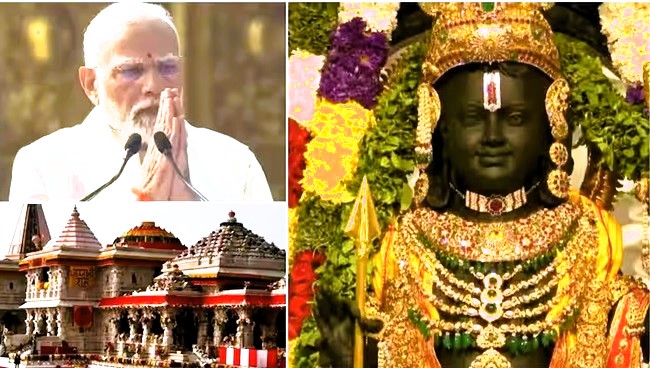Apr 14, 2025
Apr 14, 2025
The sprawling Ayodhya temple built for Ram Lalla in Nagara style on a site believed to be Maryada Rama’s birthplace was consecrated on January 22 during Abhijeet muhurta — a highly auspicious period in Vedic astrology — by the Prime Minister Narendra Modi amid chanting of hymns and conduct of rituals by a select complement of priests. Watching the sacred ceremony live the whole nation rejoiced the occasion and paid its respect to Lord Rama, the personification of Dharma, by lighting traditional diyas — earthen lamps. A truly momentous event!

This sacred ceremony has indeed brought the curtain down on the agony of Hindus. To better appreciate the significance of this day, one must first look at the history of this national trauma that began in 1528 when Mir Baqi, a general of Mughal ruler Babur, ostensibly pulled down a temple built at Sri Rama’s birthplace and constructed Babri Masjid.
Since then, several skirmishes and communal violence reported over the Ram Janmabhoomi-Babri Masjid dispute. It fueled polarization in the state of Uttar Pradesh along religious lines that rocked the state with frequent violent disturbances. After independence, it even spread to the whole of the country causing repeated religious violence threatening the very fabric of modern India.
On December 6, 1992, as the agitation reached its peak, lakhs of kar sevaks who assembled at Ayodhya from all over the country pulled down the disputed structure — Babri Masjid. This stirred up communal riots across the major cities of north India. Notably, the Hindu-Muslim riots in Mumbai, the financial capital of India, caused 900 deaths and damaged properties running into thousands of crores.
Immediately after the demolition of the mosque, a makeshift temple to Ram Lalla was built by Hindu activists. A new law was enacted by the Government of India to acquire a large area of land in Ayodhya that included the site where the mosque stood. A Presidential reference was also made to the Supreme Court to find out whether a “Hindu temple or any Hindu religious structure” existed where the mosque had been built in 1528.
The legality of this enactment and the Presidential reference were challenged by Muslim representatives in the Supreme Court. A majority decision of the Court upheld the law acquiring the land, but declined to answer the question raised in the Presidential reference observing that it was “superfluous and unnecessary”.
In September 2010, a three-judge bench of Allahabad High Court, setting aside a lower court’s order, allocated two-thirds of the disputed site to Hindu groups, with the remainder going to Muslims. It also gave a ruling — obviously, based on a 272-page report submitted by the ASI which summarized its findings as: “indicative of remains which are distinctive features found associated with the temples of north India” — that the disputed spot was Hindu God Ram’s birthplace and the mosque had been built after the demolition of a temple. But both parties appealed against the order in the Supreme Court.
Finally, in 2019, the apex court settled this fractious issue once for all by a unanimous judgment that identified the disputed site as the birthplace of Sri Rama and handed over the disputed site to Ram Lalla Virajman, and directed the Central Government to form a trust to construct Ram temple at the disputed site in Ayodhya while ruling that an alternative five-acre plot must be found for a mosque in the Hindu holy town.
It is in fulfilment of this order that the trust constructed the temple, which in the words of the Prime Minister, “will be a witness to the rise of a magnificent India”. Needless to say here that it becomes a reality only when what Mr Yogi Adityanath, Chief Minister of UP, aptly said, “Bullets will not be fired in Ayodhya, Sarayu Maiya will not be stained with blood. Curfew will not cause havoc in Ayodhya”, becomes a norm for the whole of the nation.
It is also time for the nation, as Mr Mohan Bhagwat, RSS Chief said, to “stop fighting over petty issues” and “move forward with truth, compassion, wisdom, discipline and charity”. Even the wisdom of governance commands that we must bury the past, though it is inarguable that the Islamic rulers of our past destroyed many Hindu temples, to maintain harmony and peace in the country.
It is all the more important to appreciate that there is nothing much to be gloated about it and the wisdom of statecraft lies in handling the whole issue sensitively without giving any scope for flaring up of passions. Then only it becomes feasible to accomplish what the Prime Minister desired: the application of “collective wisdom and strength … towards nation building”.
11-Feb-2024
More by : Gollamudi Radha Krishna Murty